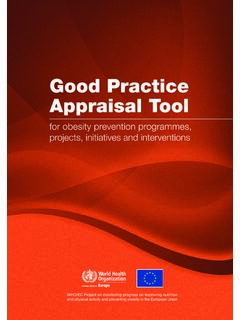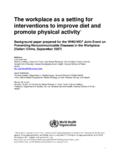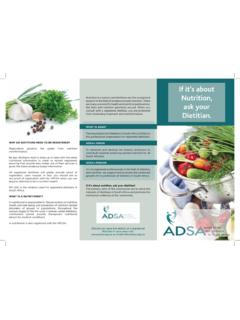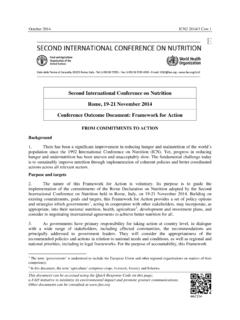Transcription of HIV/AIDS: A Guide For Nutrition, Care and Support
1 HIV/AIDS: A Guide For Nutrition, Care and SupportJuly 2001 FANTA 2001 BROCHURE 9/19/01 3:02 PM Page 1 This Guide was made possible throughsupport provided to the Food andNutrition Technical Assistance (FANTA)Project by the Office of Health andNutrition of the Bureau for GlobalPrograms Field Support and Research atthe US Agency for InternationalDevelopment, under terms of CooperativeAgreement No. HRN-A-00-98-00046-00awarded to the Academy for EducationalDevelopment (AED). The opinionsexpressed herein are those of the authorand do not necessarily reflect the views ofthe US Agency for citation: HIV/AIDS: A Guide For nutrition , Care and Support . Food and NutritionTechnical Assistance Project, Academy forEducational Development, WashingtonDC, 2001. Published September 2001 Copies of the Guide can be obtained from:Food and nutrition Technical Assistance(FANTA) Project Academy for Educational Development 1825 Connecticut Ave.
2 NW, Washington DC, 20009-5721 Tel: 202-884-8000 Fax: 202-884-8432 Email: 2001 BROCHURE 9/19/01 3:02 PM Page 27881010111112121313131414141415151516 Page number 7 INTRODUCTIONP urposeAudienceHow To Use This GuideMODULE and HIV/AIDS: Basic FactsWhat is HIV? What is AIDS?How HIV Is TransmittedHow HIV Is NOT TransmittedHIV Cases in AfricaNutrition and HIV/AIDSA norexiaDiarrheaFeverNausea/Frequent VomitingThrushAnemiaOther Nutritional Impacts of HIVHow to Maintain Good 2001 BROCHURE 9/19/01 3:02 PM Page 3 MODULE with HIV: nutrition and Other Strategies for Living PositivelyGood Nutritional PracticesEat Small but Frequent MealsEat a Variety of FoodsGrowth Promotion and Preventive Health Care for ChildrenSafe Hygienic Practices: Proper Storage and Handling of Food and WaterWaterAnimal ProductsFruits and VegetablesGeneral Foods Storage and HandlingSafer Sexual and Reproductive Health PracticesPhysical ActivityImmediate Attention for IllnessesEating During and After IllnessPsychosocial SupportInvolvement in Community ActivitiesReferencesMODULE MANAGEMENT FOR ADULTS LIVING WITH AIDS-RELATEDSYMPTOMS AND ILLNESSESP lanning Meals for PLWHAsNutritional Counseling and - continuedFANTA 2001 BROCHURE 9/19/01 3.
3 02 PM Page Issues Associated with Modern and Traditional TherapiesModern MedicationsTraditional TherapiesDiarrheaFeverCoughHeadachesSore ThroatsSores in the Mouth and ThrushShinglesOther Skin RashesReferencesMODULE and Care Recommendations for Infants/ChildrenMessages for Health Workers and Promoters Working withMothers Whose Status is Unknown or HIV-NegativeRecommendations for Health Workers and Promoters Workingwith HIV-Infected MothersReferencesMODULE Food-Based Approach to Support HIV/AIDS AffectedHouseholds and CommunitiesIntroductionCommunity-Based Care and SupportFacilitating a Community-Led Situation AssessmentDesigning and Implementing a Food ProgramSelecting Ration Size and CompositionLinking Communities with Other ServicesInstitution-Based Feeding ProgramsInstitutional Care for Severely Malnourished IndividualsReferences3031313333343434353 535363738414243434444444851545455 FANTA 2001 BROCHURE 9/19/01 3:02 PM Page 5 AcknowledgementsSerena Rajabiun was the principal author.
4 Many people and organizations contributed to this Guide . An early draft ofthe Guide was reviewed by organizations in Malawi, Uganda and organizations included: Malawi- Catholic Relief Services, LighthouseClinic, NAPHAM, Network for People Living with HIV/AIDS, US PeaceCorps/Agricultural Research Center and Save the Children; Uganda- TheAIDS Support Organization, Catholic Relief Services and The RegionalQuality of Care Center; Zimbabwe- Catholic Relief Services, The MutareCatholic Health technical input was provided by: Bruce Cogill, Tony Castleman,Paige Harrigan, Marya Khan, Sandra Remancus, Anne Swindale andCaroline Tanner (Food and nutrition Technical Assistance Project); ReneBerger, Paurvi Bhatt, Eunyong Chung, Paul Delay, Miriam Labbok, JoanLaRosa, Linda Sussman and John Williamson (USAID); Dorcas Lwanga,Micheline Ntiru and Ellen Piwoz (SARA/SANA Project, AED); Mary Kroegerand Jay Ross (Linkages Project, AED); Leslie Elder (World Bank).
5 FANTA 2001 BROCHURE 9/19/01 3:02 PM Page 6 Approximately 36 million persons are living with HIV/AIDS worldwide, 25 million of them in Africa. This Guide providesinformation for affected households and communities on how to livea healthy life from the time of infection with HIV through the progression ofthe disease. Because a majority of people may not know their HIV status, thefood/diet messages included are appropriate to help all adults and childrenlead healthier, more productive lives. The Guide does not cover drugtreatment and preventive practices, but complements other references on thistopic. This Guide is intended to help development program managers makerecommendations on food management and nutritional issues for householdswith members who are HIV-infected or living with AIDS.
6 The informationfocuses on dietary and care practices for adults during different stages of HIVand also provides suggestions for all household and community memberscoping with the infection and trying to maintain their health and Guide refers to the nutritional care and Support needs of individualsinfectedwith HIV; that is, they have the virus with or without signs of Guide is also designed for individuals, families and communities affectedby HIV; that is, they may or may not be HIV-infected but are experiencing thesocial, economic and often health consequences of the virus. The Guide isdesigned with the view that sound nutrition practices will benefit bothinfected and affected little research is available on nutritional interventions for HIV-infectedchildren, the Guide provides general recommendations for improving theirPurposeIntroduction7 FANTA 2001 BROCHURE 9/19/01 3:02 PM Page 7nutritional status.
7 Feeding recommendations for both adults and childreninclude using locally available food products, balancing food and nutritionwith medications and selecting appropriate foods through external donationprograms (such as US Title II1 and the World Food Program). Program managers and technical staff working with food aid and food security programs in HIV-affected areas who seek to design programs to meet the dietary needs of households coping with infection; Community-based organizations working with care and Support issuesfor HIV-affected households who need information on appropriate foodand nutrition practices; Institutions caring for persons living with HIV/AIDS or for children whohave lost one or more parents/guardians to HIV/AIDS; and District health leaders and community and health workers in areas affected by HIV who are assessing the needs of their communities and targeting resources to those Guide highlights thematic issues related to HIV/AIDS and nutrition .
8 Thesix modules are organized to allow program managers to select the issuesmost relevant to their programs and incorporate the information as addition, the modules can be translated and adapted and shared withcommunities and households as a reminder of the simple practices necessaryto maintain a healthy lifestyle. The six modules are: Module 1: nutrition and HIV/AIDS: Basic FactsThis module provides basic information on HIV/AIDS, the relationship between HIV/AIDS and nutrition and basic elements of good 2: Coping With HIV: nutrition and Other Strategies ForLiving PositivelyThis module provides guidelines for helping HIV-infected adults who are not showing signs of illness maintain good nutrition and health United States Title II Program is managed by the US Agency for InternationalDevelopment (USAID) Bureau for Humitarian Response, Office of Food for Peace.
9 Privatevoluntary organizations and nongovernmental organizations can solicit requests fordonated US food commodities to use in their development programs. For information,contact USAID s Bureau for Humanitarian Response at To Use This GuideFANTA 2001 BROCHURE 9/19/01 3:02 PM Page 89 INTRODUCTIONM odule 3: Food Management For Adults Living With AIDS-RelatedSymptoms and Illnesses This module provides dietary recommendations for adults who are coping with AIDS-related symptoms and illnesses. Module 4: Nutritional Issues Associated With Modern andTraditional TherapiesThis module describes the nutritional issues associated with therapies to treat HIV-related illnesses and symptoms. Many people may take modern medications, such as antibiotics, or use traditional therapies such as food and herbs to manage AIDS-related 5: nutrition and Care Recommendations For Infants andChildrenThis module provides feeding and care recommendations for infants and children regardless of HIV 6: A Food-Based Approach To Support HIV/AIDS AffectedHouseholds and Communities This module provides information on the selection, composition and size offood commodities, to program managers who address HIV-affected populations at the community and institutional 2001 BROCHURE 9/19/01 3.
10 02 PM Page 910 This module provides basic facts onHIV/AIDS, the relationship betweenHIV/AIDS and nutrition and basicelements to maintain good nutrition inadults. This module is designed to provideprogram managers with basic informationto share directly with households andcommunities. The information is focusedon sub-Saharan is HIV? What is AIDS?H= Human (who is affected)I = Immunodeficiency (the result)V= Virus (the causal agent)A= Acquired (from bodily fluids through a behavior or action, including from the mother during pregnancy, during delivery or through breastmilk) I= Immune (where the virus attacks)D= Deficiency (resulting effect of virus)S= Syndrome (series of illnesses; not just one)Acquired Immune Deficiency Syndrome,or AIDS, is a disease caused by a retrovirusknown as the Human ImmunodeficiencyVirus (HIV), which attacks and impairs thebody s natural defense system againstdisease and infection.

















